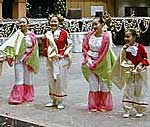Hmong Celebrate New Year
By Tom Scheck
November 24, 2000
The Minnesota Hmong population is the largest in the United States and is celebrating the 23rd Annual New Year's celebration in Saint Paul.
WHILE THOUSANDS OF MINNESOTANS woke Friday morning with plans to start their Christmas shopping, thousands of Minnesota's Hmong population donned traditional outfits to begin the traditional celebration of the New Year.
The costumes feature a kaleidoscope of colors, from hot pink to deep blue. The traditional outfits also include chains around the wearers' waists. The chains ring with even the slightest movement. Leaders in the Hmong community say the New Year's celebration is the biggest event in their culture.
Thomas Yang, chairman of the Saint Paul New Year celebration, says while many come for the traditional costumes, dances and food, for others the celebration is time for courtship.
"It has been celebrated for thousands and thousands of years and it's still practiced today even in America and Hmong people are very interested in bringing their children together to gathering and finding a daughter-in-law or son-in-law," he says.
With traditional music and dancing in the background, hundreds of Hmong teenagers take part in a traditional courtship ceremony. During the ceremony, young men and and women line up and face each other. The line of women giggle at each other as they toss a tennis ball-sized object to the line of young men just a few feet away. The hope is the ball toss will become an icebreaker between the young men and women.
The ritual worked for Toua Yang and Chue Lor, who courted Kay and Nallie Thao. Kay and Toua say the courtship ceremony is a good way to meet other people their age.
"It's like a mixer. You go up to see whoever you like and go up to them and talk to them and if they want to actually converse, then you start throwing the ball and hopefully get something further than that," Yang says.
The teenagers say the courtship ceremony is just one aspect of Hmong culture that the New Year's celebration keeps keep alive.
Hmong families often spend a year or so to make the traditional costumes. Learning the traditional songs and dances also takes time. The four teenagers are dressed in traditional garb and say their parents continue to stress the Hmong culture to them.
Toua Yang says many people his age are struggling to maintain the traditional customs with their modern lives in the United States.
"Some of the kids and teenagers around here wear American clothes. Usually you wear a fancy suit or Hmong clothing and most kids or some kids wear casual or regular day clothes and that really puts a damper on the event and the whole meaning of the New Year," Yang says.
Nevertheless, Yang says there are many teenagers who will adapt many parts of the Hmong culture into their everyday lives.
By Tom Scheck
November 24, 2000
|
|
RealAudio |
The Minnesota Hmong population is the largest in the United States and is celebrating the 23rd Annual New Year's celebration in Saint Paul.
| |
|
|
|
||
The costumes feature a kaleidoscope of colors, from hot pink to deep blue. The traditional outfits also include chains around the wearers' waists. The chains ring with even the slightest movement. Leaders in the Hmong community say the New Year's celebration is the biggest event in their culture.
Thomas Yang, chairman of the Saint Paul New Year celebration, says while many come for the traditional costumes, dances and food, for others the celebration is time for courtship.
"It has been celebrated for thousands and thousands of years and it's still practiced today even in America and Hmong people are very interested in bringing their children together to gathering and finding a daughter-in-law or son-in-law," he says.
With traditional music and dancing in the background, hundreds of Hmong teenagers take part in a traditional courtship ceremony. During the ceremony, young men and and women line up and face each other. The line of women giggle at each other as they toss a tennis ball-sized object to the line of young men just a few feet away. The hope is the ball toss will become an icebreaker between the young men and women.
The ritual worked for Toua Yang and Chue Lor, who courted Kay and Nallie Thao. Kay and Toua say the courtship ceremony is a good way to meet other people their age.
"It's like a mixer. You go up to see whoever you like and go up to them and talk to them and if they want to actually converse, then you start throwing the ball and hopefully get something further than that," Yang says.
| |
|
|
|
| |
|
Hmong families often spend a year or so to make the traditional costumes. Learning the traditional songs and dances also takes time. The four teenagers are dressed in traditional garb and say their parents continue to stress the Hmong culture to them.
Toua Yang says many people his age are struggling to maintain the traditional customs with their modern lives in the United States.
"Some of the kids and teenagers around here wear American clothes. Usually you wear a fancy suit or Hmong clothing and most kids or some kids wear casual or regular day clothes and that really puts a damper on the event and the whole meaning of the New Year," Yang says.
Nevertheless, Yang says there are many teenagers who will adapt many parts of the Hmong culture into their everyday lives.

